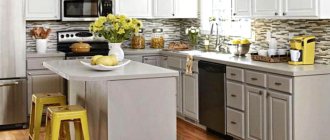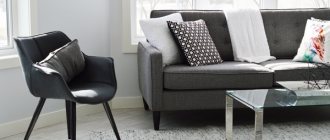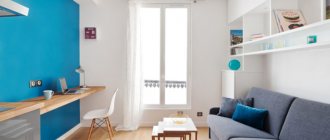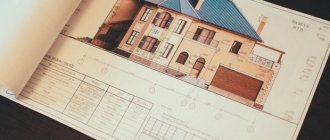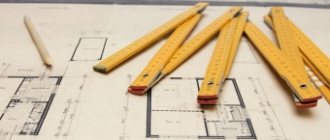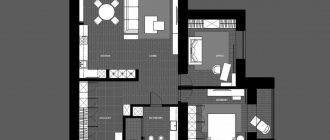What does the living area of the apartment include? To be honest, this question interests many. Indeed, depending on this indicator, the value of the property will change. The higher it is, the more the apartment costs. Therefore, you have to thoroughly understand this topic. What you should pay attention to? How to calculate the area of an apartment and its living part? All this is not so difficult to understand. It is enough to know modern legislation.
Three components
Before you find out what the living space of an apartment includes, you need to understand what types of space are available in the home. After all, this is extremely important. Especially if you are the buyer of a particular apartment. At the moment we can highlight:
- total area;
- residential;
- useful.
Remembering these points is not so difficult. According to modern legislation, specific premises are classified as a particular area. But which ones exactly? And what does each point mean?
Studio apartment or regular one-room apartment
In the homeland of studios, in the USA, housing of this type has a second name - “bachelor's flats”. Indeed, due to the almost complete lack of privacy, the studios will be comfortable only for singles or couples who match the time rhythm. Studio apartments are also popular among investors - after all, you can buy a studio much cheaper than a one-room apartment, but the level of rent when renting out “studio” housing will be the same as for ordinary “one-room” apartments.
- Inability to have privacy. The studio can accommodate only one sleeping area, not separated from other rooms. This can be a problem for those who often have friends staying over, and makes the studios virtually unsuitable for families with children. Disagreements are possible even among couples - for example, if one has to get up early in the morning for work, the other may not expect to soak in bed until lunchtime.
- Free movement of sounds and smells. Many people don't like food odors hanging around in their living spaces, especially in the bedroom. In order to avoid the spread of odors, you will have to equip a powerful hood. However, solving the problem of soundproofing will be much more difficult, especially for couples.
- Disadvantages of planning. Studios in economy-class houses usually have a rectangular layout, which is not particularly convenient for zoning. And just one window in a room measuring 35 - 40 m in our climate zone can mean a lack of natural light, especially in winter. Studios also usually do not have a balcony. However, business class studio apartments do not have such disadvantages - they often have a more ergonomic square layout and panoramic glazing from floor to ceiling.
Definitions
What does the living area of the apartment include? The law, or more precisely, the Housing Code of the Russian Federation, reveals in detail the answer to this question. First, it’s worth understanding what each type of space in a home means.
There is such a thing as total area. This is nothing more than the sum of the space of all residential and non-residential premises. This does not include balconies and loggias. We can say that this is the entire apartment.
Useful - an indicator reflecting the sum of the areas of residential and non-residential premises, but including utility rooms. This is exactly the definition that applies in Russia. In other countries, only the space used is called useful.
To understand what the living area of an apartment includes, you need to understand the definition of this term. We can say that this is the amount of space in premises suitable for habitation.
Purpose of living space and its use
Modern legislation has eliminated the restrictions that existed in the legislation of the USSR regarding the number and area of housing per citizen. At the same time, the elimination of limits on the exercise of property rights, according to legal scholars, should not lead to unlimited freedom to exercise it.
When speaking about the limits of the right to housing, the legislator points only to the law. When considering restrictions, the legislator refers to the will of the owner or other user of housing and the entity entering into an agreement with him, based on the law, or to the will of the judicial authorities.
The limits are objective - they do not depend on the will of the owner and other persons, but are predetermined by law. Restrictions are subjective - they depend on the legal will of the subjects or judicial authorities.
The Russian legislator, setting the limits for the exercise of property rights in relation to any property, proceeds from the principle “You can do everything with your property that does not violate the rights of other entities.” By regulating relations related to real estate in the housing sector, this principle is also projected onto the right of ownership of residential premises (Article 209 of the Civil Code of the Russian Federation, Article 17 of the Housing Code of the Russian Federation; hereinafter referred to as the Housing Code of the Russian Federation).
Article 17 of the Housing Code of the Russian Federation establishes the following limits for the use of residential premises, regardless of their type:
- Residential premises are intended for the residence of citizens. It is not allowed to locate industrial production in residential premises, or carry out missionary activities in residential premises, except for the cases provided for in Art. 16 of the Federal Law of September 26, 1997 N 125-FZ “On freedom of conscience and religious associations.”
- The use of residential premises must be carried out taking into account the rights and legitimate interests of citizens and neighbors living in this residential premises, fire safety requirements, sanitary and hygienic, environmental and other legal requirements, as well as in accordance with the rules for the use of residential premises approved by the federal government authorized by the Government of the Russian Federation executive authority (part 4 of article 17 of the Housing Code of the Russian Federation).
Part 2 art. 17 of the RF Housing Code allows the use of residential premises for professional activities or individual entrepreneurial activities.
It is important to understand that two conditions must be met:
- such activities are carried out by persons living in residential premises legally (ownership of residential premises, lease agreement);
- such use of residential premises does not violate the rights and legitimate interests of other citizens, as well as the requirements that the residential premises must meet.
The types of professional activities of persons in creative professions, such as writers, artists, musicians, etc., are compatible with residence. They usually work at home.
Clause 7 art. 21 Federal Law No. 63-FZ “On advocacy and the legal profession in the Russian Federation” gives lawyers the right to use residential premises to house a lawyer’s office. Lawyers can work in premises occupied by them and members of their families under a rental agreement, having secured the consent of the lessor, as well as all adults living with them.
The law does not define the use of housing for other purposes. This gap is partially closed by the Resolution of the Plenum of the Court of the Russian Federation dated July 2, 2009 No. 14 “On some issues that arose in judicial practice when applying the Housing Code of the Russian Federation.”
The court determined that the use of residential premises for purposes other than their intended purpose should be understood as the use of the object not for the residence of citizens, but for other purposes. For example, for offices, warehouses, industrial production, keeping and breeding animals. Simply put, the court determined that the misuse of housing is actually turning it into non-residential premises.
Living space
Many people are interested in exactly what components are included in the concept of living space in an apartment. The question is controversial. Especially if we consider not a studio apartment, but an ordinary home. It can have a huge variety of rooms.
For example, does the living area of an apartment include a kitchen? No. After all, just by one definition of the term it is clear - residential is an area suitable for living. And the kitchen is not included here. Even if it is completely refurbished so that you can sleep here.
Thus, the living area is the total sum of all living rooms. This includes: bedrooms, children's rooms, living rooms, guest rooms and so on. But the hallway bathroom and kitchen cannot be classified as residential. The balcony does not apply here either. Calculating this component is easy and simple. First, calculate the space in each room, then add everything up. Everything is easy and simple!
Norms, rules and studio apartments
In the vast majority of studios, the only partitions in the apartment are the walls separating the bathroom from the rest of the apartment. In this case, the room, kitchen and corridor form a single space from which the entrance to the bathroom is arranged. Not only do you have to live in cramped conditions, but you also have to put up with dirt from the hallway, noise coming through the front door, smells wafting throughout the apartment when cooking, and disregard for generally accepted sanitary standards.
A studio apartment is a one-room apartment in which the living area is not divided by main walls into two or more rooms, but its area allows the owner, observing the rules and regulations, to carry out such a redevelopment by constructing interior partitions. In other words, a studio apartment is an open-plan apartment in which the living area has two or more windows and the living area of which is at least 24 square meters.
General
Does the living area of the apartment include a kitchen? No, we already found that out. But then what can this room be classified as? It is worth remembering such an item as the total area of the apartment. She also plays a certain role. The definition of this term has already been given. But what does this concept mean?
We found out what the total living area of the apartment includes. SNIP (1-71 “Residential buildings” dated January 31, 2003) indicates that, as already mentioned, all residential and non-residential premises are classified as common space (not residential). There can be many items, it all depends on your apartment.
Based on this law, the following components of the common space can be distinguished:
- bedrooms;
- living rooms;
- kitchens;
- hallways;
- bathroom;
- toilet (with separate bathroom);
- wardrobe.
In general, this includes all premises, with the exception of balconies, loggias, and terraces. These are the rules that apply in Russia. Typically, the total area is the sum of all rooms in an apartment. The calculation is simple - add up all the space in all “rooms”.
How to measure
Information for all rooms is indicated in the technical passport for the apartment. Sometimes it happens that there are discrepancies in the actual measurements. For measurements, in addition to the technical passport, you will need a tape measure, paper, calculator and pencil. The actions are:
The apartment diagram is drawn on a sheet of paper. You also need to draw utility rooms - storage rooms, built-in wardrobes.
Using a tape measure, measure the length of the walls according to the level of the baseboard. The amounts are converted into meters and recorded on the diagram.
If there are curves or recesses in the configuration of the room, it is divided into separate figures, each with its own value indicated.
Odds
How to calculate the area of a particular apartment? It's actually not that difficult. It is enough to know a few rules. They are prescribed in SNIPs. Which ones? Speaking about calculations carried out in apartments, it is worth taking into account SNIP 2.08.02-89. It indicates that living space will be calculated with certain coefficients for certain premises. Which ones?
For loggias, this indicator is set to 0.5, balconies and terraces - 0.3, and verandas and storage rooms are counted with a coefficient of 1.
In general, calculating the area of a particular housing is not so difficult. Remember all the areas of primitive geometric shapes. We need to build on them. For example, for a square room you will have to use the formula for calculating the area of a square. Nothing difficult. Accordingly, rectangular rooms are calculated in a similar way. Simple mathematical knowledge is enough to understand the problem.
Some people think about how to properly measure walls. This is a valid question. After all, if you measure the walls incorrectly, you will end up with the wrong area. Usually it increases. In real estate transactions, such errors are beneficial to the seller. But for buyers - no.
Please note that all measurements to calculate the area of the apartment should be made on the inside of the baseboard. This is the rule that will help prevent errors in calculations. Nothing difficult or special!
How to calculate the area of an apartment?
There are two ways to find out the size of the living and common areas of a particular home - independently or with the help of qualified specialists. If determination of these values is required for the purpose of selling an apartment, it is recommended to use the services of organizations specializing in calculating area.
To independently calculate the dimensions of a particular room, just measure its width and length along the floor, and then multiply both values. This method of determining the area of a separate room is suitable if the room is rectangular. The value is measured along the internal walls along the baseboard.
Information on the housing area is contained in the technical passport issued by the BTI. To obtain it, the apartment owner needs to contact the bureau office with the documents listed below:
- ID card;
- request for service provision;
- title documents for residential premises;
- a check confirming payment of the state duty (its amounts are set individually depending on the region of Russia).
The production period for this document is no more than 14 days, although for an additional fee the registration certificate can be issued within a week. Its validity period is formally unlimited, but it is recommended to update this document every five years.
If a technical passport has not yet been issued, the owner of the premises first needs to call a technical engineer who will carry out the necessary measurements. If changes have occurred in the apartment (for example, remodeling a room), you should also call a specialist again to enter new information into the housing registration certificate.
In addition, many organizations that provide their services on a paid basis carry out the calculation of common and residential areas.
The positive side of contacting such a company is the speed of taking measurements and documenting the results of the work. The cost of services depends on the prices of a specific company and region of Russia.
Registration of a deed of gift for an apartment between relatives here https://metrtop.ru/dokumenty/oformlenie-darstvennoy-na-kvartiru-mezhdu-rodstvennikami/. Read how to find out the cadastral value of housing here.
How to find out the rent arrears on a personal account?
Additional inclusions
What else should you pay attention to? On what the living area of the apartment includes! The joint ventures indicate that the common apartment space should include not only the “dimension” of the premises. Sometimes niches and partitions with walls are also included here. Under what conditions? If this:
- niche higher than 2 meters;
- arch more than 200 centimeters;
- internal staircase (the space under it is taken into account);
- heating stoves;
- other protruding structures.
Basically, that's all. Now the main points that are important for both real estate buyers and sellers are clear. In order not to suffer for a long time with calculating areas, you can call special measurers - they will quickly help you correctly calculate both the total space in the housing and the living space. Usually there are no difficulties with this.
Another option is to take a BTI extract for a particular apartment. It will contain a detailed plan with all areas and data regarding the “dimension” of the property. Don't forget to request a similar document from the seller when dealing with housing.
What rights do real estate buyers have?
When calculating the cost of real estate for sale in a new building, house-building companies designate loggias or balconies in general terms, although they are required to indicate their total area and present regulatory documents of the housing legislation of the Russian Federation.
For example, in addition to the real estate purchase and sale agreement, the square footage of the loggia is calculated with an underestimation factor of 0.3 or one to one. This fact confirms the violation of the rules of the housing legislative framework of the Russian Federation and the deliberate deception of shareholders.
Sometimes the developer misleads participants in shared construction, claiming to buyers that he is guided by the housing legislation of the Russian Federation. For example, it imposes information on clients—buyers—that certain additional rooms in the apartment do not belong to living space, although this space is paid for upon purchase.
If you found yourself in such a situation and bought real estate, and paid more than the required amount, and later it turned out from the BTI registration certificate that the square footage turned out to be less, you need to file a claim in court.
Such legal proceedings will always be in favor of the plaintiff, since:
- the buyer was deceived;
- measurements of the square footage of the housing were carried out without the buyer;
- the buyer of real estate should not pay for an incorrectly calculated square footage;
- the developer is responsible for errors in measurements.
What housing issues are resolved in court?
- If the house has been put into operation, and there are discrepancies in the quadrature in the technical passport from the BTI.
- You overpaid for the purchased property as a result of incorrect square footage measurements, and the construction company does not return the money.
- Filing a lawsuit is an effective way to recover unnecessarily spent money. Sometimes construction companies are guided by outdated regulatory documents of the old model of building codes and rules 2.08.01-89, on the basis of payment for excessively calculated square footage.
During the trial, the court carefully considers the versions of both parties if they appeared at the hearing of their own free will.
Balcony and loggia - are they included in the total area of the apartment?
And also, the court takes into account the fact of the general agreement of both parties regarding shared construction:
- regarding the construction and transfer to the customer of an apartment with the specified area;
- the buyer became the owner of an apartment from a construction company with an area much smaller than what was agreed upon in advance;
- since the design area of the apartment and other technical measurements are calculated without the involvement of the shareholder, and he, in turn, fully relies on the honesty of the construction company, that is, all measurements must be carried out according to the rules specified in the “Instructions for accounting of housing stock in the Russian Federation.” Therefore, the developer bears full responsibility to the buyer for providing incorrect dimensions;
- the customer has every right to recover monetary penalties from the construction company for failure to fulfill agreements and guarantees.
Therefore, in order to understand the square footage of real estate, it is necessary to clarify the difference between the total and living area. The sum of the heated parts of the apartment, as well as auxiliary premises - this is the corridor, kitchen, toilet room - all this is the total area of the apartment.
Consequently, utility payments are made for the area of premises in the apartment intended not only for living, but also for domestic needs, except for balconies, verandas, loggias, and terraces.
Composition of apartment premises
All types of kitchens are equipped with stationary kitchen equipment and special furniture. The main piece of equipment is a gas, electric or solid fuel stove (depending on local conditions). Next to the stove there is a work table with a built-in sink, which is also a cabinet for storing kitchen equipment. Above the table there are wall cabinets for storing dinner and tea utensils and food.
A niche kitchen is a kitchen whose equipment is located in a niche in the living room or hallway. Such kitchens are rational in hotel-type houses in apartments designed for one or two people who run the household to a minimum extent. This type of kitchen is permissible only if it is equipped with an electric stove and artificial exhaust ventilation.
We legalize the transfer of the kitchen to the living room: reasons
- placement of bathrooms and toilets above kitchens and living spaces (SanPiN 2.1.2.2645-10; SNiP 31-03-203);
- moving the kitchen to the living room (clause 22, Decree of the Government of the Russian Federation No. 47 of January 21, 2006);
- placement in the freed-up area of a bedroom, nursery or even living room;
- combining a gasified kitchen with rooms for permanent residence.
- Apartments and their parts. An apartment is considered a dedicated room in an apartment building, consisting of one or more rooms, as well as auxiliary premises, those that provide for a person’s everyday needs (Part 3 of Article 16).
- Rooms. This is a narrower concept with exclusively residential purpose of premises (Part 4 of Article 16).
We recommend reading: Sample application for payment of a lump sum birth benefit 2020
